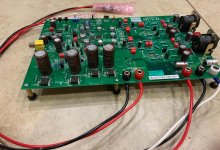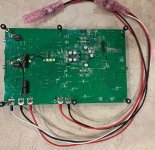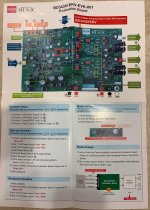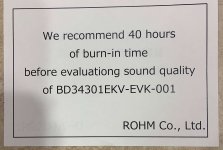Rohm BD34301EKV-E2 chips are now available at Digi-key: Blocked
However, no eval boards in stock yet.
It looks like the eval boards use AK4118. What are the chances Rohm has those in stock
Why would anybody pay that kind of money for this Rohm DAC? Now that the datasheet is available, it looks inferior even to the ESS ES9038Q2M (and the now MIA AKM) chips, and more or less at par with the Cirrus CS43198 (which is x7 times cheaper). This looks, smells and quacks like a new audiophile marketing story in the breeding. And if I'm reading correctly the almost unreadable schematic, the demo board uses the NE5532 op amps, that's outrageous in 2021.
indeed that eval board is ridiculously priced and bizarro and the schematic barely readable. its a cynical design IMO, that uses through hole caps and resistors on a VERY basic instrumentation amp, just in the positions that modders would like to replace and where 'tweakers' would complain that SMD sounds horrible and respond well to a handful of pretty coloured parts scattered. if that is what they used to characterise the chip, I wouldnt be surprised to find that its datasheet performance can be bettered. Thats what i'm hoping anyway. i'm just happy to have another option instead of ESS or ESS. the CS part doesnt fit the bill for me and although its expensive (so is there reg ... omg $20aud for that that fails in comparison to LT at 1/3 the price) the difference isnt huge when all other factors are considered and accounted for and it will likely cost me less in power supplies vs ESS, which need babying in that regard to reach spec.
bizzarro? thanks 'autocorrect'
asa sidenote, the internal routing the designer has done around the chip on the eval board is actually quite elegant and visually striking too; in a particularly Japanese way. if you go in and look at the layers in the gerber, its quite intricate. one layer has been blurred and is basically unreadable, I guess as an IP matter, but it is annoying for those wanting to have the full picture wrt application. That's why I took it as a cynical IV stage
asa sidenote, the internal routing the designer has done around the chip on the eval board is actually quite elegant and visually striking too; in a particularly Japanese way. if you go in and look at the layers in the gerber, its quite intricate. one layer has been blurred and is basically unreadable, I guess as an IP matter, but it is annoying for those wanting to have the full picture wrt application. That's why I took it as a cynical IV stage
Why would anybody pay that kind of money for this Rohm DAC? Now that the datasheet is available, it looks inferior even to the ESS ES9038Q2M (and the now MIA AKM) chips, and more or less at par with the Cirrus CS43198 (which is x7 times cheaper). This looks, smells and quacks like a new audiophile marketing story in the breeding. And if I'm reading correctly the almost unreadable schematic, the demo board uses the NE5532 op amps, that's outrageous in 2021.
I'd have to guess it's that weird Japanese behavior often seen in electronics where they do completely nonsensical things just to be different. Rohm is mostly a second-source vendor selling old / low-end and automotive parts. Why they decided to make an audio DAC is a mystery. Probably just the whim of someone high up in management.
As far as the NE5532, not sure, but it's probably like AKM using 7805 regulators. I've noticed these manufacturers like to use locally made products where they can. They are almost always JRC or another Japanese mfg, highly doubt it's a TI 5532.
At least you can buy it, I suppose. The CS43198 is actually not easy to get right now unless you want the WLCSP package that requires microvias to escape.
Why would anybody pay that kind of money for this Rohm DAC? Now that the datasheet is available, it looks inferior even to the ESS ES9038Q2M (and the now MIA AKM) chips, and more or less at par with the Cirrus CS43198 (which is x7 times cheaper). This looks, smells and quacks like a new audiophile marketing story in the breeding. And if I'm reading correctly the almost unreadable schematic, the demo board uses the NE5532 op amps, that's outrageous in 2021.
Downloaded Eval Board PDF and indeed, I-V uses 5532's.
FWIW, I once did a thorough noise calc on the PCM1792 and concluded that the 132dB DR in mono mode was limited by the 5534 I-V opamps and the DAC itself is capable of slightly better.
Wonder if this is the case with Rohm not to mention distortion?
Mark, I take it you will be digging out some 1612's
TCD
I'd have to guess it's that weird Japanese behavior often seen in electronics where they do completely nonsensical things just to be different. Rohm is mostly a second-source vendor selling old / low-end and automotive parts. Why they decided to make an audio DAC is a mystery. Probably just the whim of someone high up in management.
As far as the NE5532, not sure, but it's probably like AKM using 7805 regulators. I've noticed these manufacturers like to use locally made products where they can. They are almost always JRC or another Japanese mfg, highly doubt it's a TI 5532.
At least you can buy it, I suppose. The CS43198 is actually not easy to get right now unless you want the WLCSP package that requires microvias to escape.
theyve kinda been hinting at it for a while. they have been making some pretty decent low RDSON fets and dabbling in class D audio IIRC, but indeed, its quite a leap, to move into high spec audio. it would have to be a pet project I reckon as well.
Downloaded Eval Board PDF and indeed, I-V uses 5532's.
FWIW, I once did a thorough noise calc on the PCM1792 and concluded that the 132dB DR in mono mode was limited by the 5534 I-V opamps and the DAC itself is capable of slightly better.
Wonder if this is the case with Rohm not to mention distortion?
Mark, I take it you will be digging out some 1612's
TCD
Yes, I mean it was possible to beat the ESS datasheet spec with careful application. I have a hunch it might be possible to get closer to -120dB THD. they are using their new reg for all the analogue supplies and although its priced as if its better than anything else available, its worse than LT3042/5/0 in every metric. combine that with the use of those old opamps in a very basic arrangement and it may just be doable.
It should be fun trying anyway and at this level of performance, for audio, it may as well be the same as ES9038, given 5db of THD and DNR at below 115db is unlikely to make me screw up my nose in disgust ... lol. I dunno, Mark reckons he can hear to this level, so he may not like it at all
and yes, I can buy it and thats a big plus for 2021.
The 5532 are TI brand. The Rohm regulators use all Rubycon PPS SMD caps. Just the 10uf output caps are about $10 each at Digikey. Output stage uses all through hole passives including Wima films. Opamp bypasses appear to be Rubycon PPS SMD. Most of the electrolytics are Silmic 2.
Also, the board is indeed very intricate. It appears to be designed to allow for many different kinds of experiments. Could be in some places there are using PCB fill to ground plane capacitance to make some very low ESR distributed caps. The grounding scheme appears to be patchable with soldered wire jumpers on the bottom of the board.
More later. I will try to post some pics when I have a chance.
Also, the board is indeed very intricate. It appears to be designed to allow for many different kinds of experiments. Could be in some places there are using PCB fill to ground plane capacitance to make some very low ESR distributed caps. The grounding scheme appears to be patchable with soldered wire jumpers on the bottom of the board.
More later. I will try to post some pics when I have a chance.
yes, the arrangement and combination of SMD passives is very similar to what i've got on my boards (except i'm using a fair bit of ceramic decoupling too), with PML, pps. I believe the larger rubycon PML caps like the 10uf are acrylic, rather than pps. pricey. I bought a bunch years ago along with the pana pps, but I was blown away by how much those and the ltc6655 references have increased in price since my past purchase. it doesnt surprise me about the jumpers for ground, the pin descriptions of all the analogue supplies and analogue grounds and whether they are separate are a bit ambiguous in the DS and I need to study it in detail. I look forward to your photos and some more time available to study the DS some more.
btw, i was referring to their regs being priced stupidly at 20aud at digikey, when lt3040 is only $8, with much better spec, much wider input and output voltage range, vs their 5.5v? max input
btw, i was referring to their regs being priced stupidly at 20aud at digikey, when lt3040 is only $8, with much better spec, much wider input and output voltage range, vs their 5.5v? max input
Last edited:
Regarding the Rohm regulators, given all the PPS caps instead of the usual class II ceramics, think they are trying to better LT304x in terms of some unstated metric, say, perhaps better linearity, better looking transient response?
Looking at data sheet shows very well controlled load transient response for a
step from 0mA to 500mA. 0mA being the difficult scenario. The LT3045 shows load step from 10 to 500mA.
Of course it's always difficult to compare because board layout / trace inductances / OP caps make all the difference.
The PML caps are not too far off MLCC WRT HF performance for similar size.
TCD
- Home
- Source & Line
- Digital Line Level
- Luxman uses ROHM Semiconductor MUS-IC BD34301EKV dac



